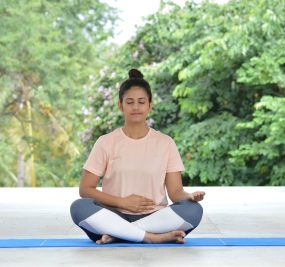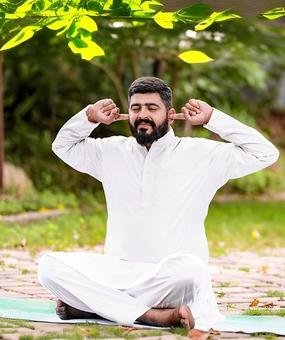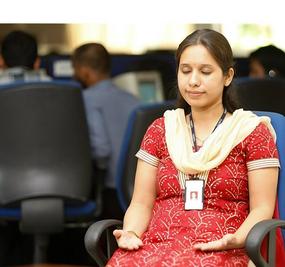Diabetes, particularly Type 2 diabetes mellitus (T2DM), is a chronic condition characterised by elevated blood sugar levels. The rising incidence of diabetes is largely attributed to urbanisation, sedentary lifestyles, and unhealthy eating habits. Effective management of diabetes involves significant lifestyle changes, including diet control, regular physical activity, and stress management. Yoga, with its holistic approach, can become a valuable adjunct in someone’s journey in regulating blood sugar levels and enhancing overall well-being.
Diabetes Management
Through mindful movement, breathing exercises, and meditation, yoga can be a valuable component of comprehensive diabetes management. Yoga offers numerous benefits for managing diabetes by improving metabolic health through:
Enhanced Insulin Sensitivity
- Yoga stimulates insulin-producing cells and improves glucose utilisation. Regular yoga practice improves insulin sensitivity by stimulating insulin-producing cells in the pancreas and aiding in better glucose utilization.
Improved Circulation
- Better blood flow and muscle relaxation support insulin receptor function. Improved blood supply to the muscles and muscular relaxation enhances insulin receptor expression, increasing glucose uptake and reducing blood sugar levels.
Regulated Lipid Levels
- Yoga contributes to healthier cholesterol and improves lipid levels, including serum total cholesterol, LDL, and VLDL. Yoga also improves lipid levels, including serum total cholesterol, LDL, and VLDL.
Stress Reduction
- Calming the mind helps lower cortisol levels, which can positively impact blood sugar control. Improved physical fitness, maintaining a healthy body weight, and stress reduction are additional benefits. Yoga calms the mind and reduces cortisol levels. Yoga enhances metabolic health by improving body strength, flexibility, and relaxation.
Paschimottanasana (Seated Forward Bend)
- Massages and stimulates abdominal organs, improving insulin sensitivity.
Vrikshasana (Tree Pose)
- Reduces stress, a significant factor in glucose regulation.
Setu Bandhasana (Bridge Pose)
- Stimulates abdominal organs and improves digestion.
Balasana (Child’s Pose)
- Gently stretches the hips, thighs, and ankles, reducing tension.
Supta Matsyendrasana (Reclining Twist Pose)
- Compresses the abdomen, aiding insulin production regulation.
Adho Mukha Svanasana (Downward-Facing Dog Pose)
- Improves circulation, benefiting diabetic neuropathy.
Sarvangasana (Shoulder Stand)
- Stimulates the thyroid gland, improves metabolism, and aids in weight management.
Dhanurasana (Bow Pose)
- Strengthens the back and abdominal muscles, improving posture and stimulating abdominal organs.
The asanas offer various benefits, including
- Relaxation, strengthening, and balancing of muscles. Also mobilization of joints.
- Action on pressure points
- Improvement of breathing & promoting homeostasis in cardiovascular, digestive, endocrine, and other systems
Also, at the Sri Sri School of Yoga, through a blend of therapeutic yoga sessions, mindful meditation, and nutritional education, the Yoga Therapy Program for Blood Sugar Balance aims to empower individuals with type-2 diabetes to take control of their health and well-being, cultivating lasting habits for a life of vitality and balance.
Also Integrating Sudarshan Kriya Yoga (SKY) into Diabetes Management helps a lot. Sudarshan Kriya Yoga (SKY) is a cyclic rhythmic breathing technique developed by the Art of Living Foundation.
Research on SKY and Diabetes Mellitus
Immediate Benefits of SKY: Study by Anupama et al
- This study revealed that SKY significantly improved fasting blood sugar by 35%, reduced total cholesterol by 19.7%, and decreased triglyceride levels by 24.9%. HDL (good) cholesterol increased by 36.9% after just 6 days of SKY practice. These results suggest that SKY can effectively complement traditional treatments by improving glycemic control and lipid profiles.
Long-Term Benefits of SKY: Study by Agte and Tarwadi
- Over a 4-month period, participants practicing SKY experienced a 17.36% reduction in fasting blood glucose and a 4.64% drop in HBA1c levels. Additionally, triglycerides dropped by 16.3%, and cholesterol levels decreased by 14.6%. This study highlights SKY’s potential as a corrective strategy, showing greater benefits for those with more severe metabolic imbalances.
Quality of Life Improvements: Study by Jyotsna et al
- This research assessed the impact of SKY on quality of life among T2DM patients. The SKY group showed improved glycemic control and a 9% increase in quality of life scores after 9 months, compared to a slight deterioration in the non-SKY group. The study underscores SKY’s role in not only managing diabetes but also enhancing overall well-being.
Guidelines for Starting Yoga & SKY in Diabetes Patients
Work with Certified Trainers
- At the Sri Sri School of Yoga, the Yoga Therapy Program for Blood Sugar Balance empowers individuals with Type 2 diabetes to take control of their health and well-being. This program blends therapeutic yoga sessions, mindful meditation, and nutritional education to cultivate lasting habits for a life of vitality and balance.
Start Slowly
- Begin with gentle practices and gradually increase intensity.
Monitor Blood Sugar Levels
- Regularly check levels, especially when introducing new practices.
Stay Hydrated
- Drink water before and after sessions.
Be Consistent
- Incorporate yoga and SKY into your daily routine for optimal benefits.
Combining Yoga, Conventional & Traditional Medicine in Diabetic Care
Yoga, along with Ayurveda, the traditional Indian medicine (TIM), can reduce fasting sugar levels (FBS), PPBS (Post Prandial Sugar Levels), and HBa1c (3-month Diabetes Tests) in all types of diabetes. Proper medications, insulin titration under a physician, avoiding excess medication, along with diet restrictions, are key. A balanced diet, calorie and carbohydrate restriction, physical activities like walking, and regular yoga practice have proven outcomes. Stress reduction and better sleep control can bring effective changes in any metabolic syndrome and help prevent diabetic complications in today’s scenario.
References–
- https://www.youtube.com/watch?v=vxyegOLcwvY Role of yoga in managing diabetes
- https://www.thip.media/news/trending/yoga-for-snoring-namaste-quiet-nights/75150/
- https://www.onlymyhealth.com/only-my-health-conduct-sessions-under-diabetes-free-india-campaign-a-step-towards-heathy-india-1710840902
- https://www.thip.media/health-news-fact-check/fact-check-is-there-a-new-drug-which-can-cure-diabetes/54628/
- https://www.thip.media/health-news-fact-check/fact-check-can-diabetes-be-cured-with-herbs-in-90-days/43244/
- https://www.facebook.com/nivaranhealth/videos/on-occasion-of-gurudev-sri-sri-ravi-shankars-birthday-and-art-of-living-aol-turn/692438395200029/?locale=ms_MY
- https://nivaranhealth.com/how-does-yoga-help-in-reducing-diabetes/
- https://m.dailyhunt.in/news/india/english/the+india+saga-epaper-indsaga/science+behind+sudarshan+kriya+sky+technique+by+dr+ayush+chandra+delhi+ncr-newsid-n386865834?s=a&uu=0x4eb5517277b8d1f4&ss=pd
- https://www.ssiar.org/whitepaper/sky%20and%20diabetes%20wp.pdf
- Anupama N, Malhotra V, Garg R, Venkiduswami R. Beneficial effects of Sudarshana Kriya in type II DM mellitus. Journal of Evolution of Medical and Dental Sciences. 2014 Jul 7;3(27):7492-7.
- Agte VV, Tarwadi K. Sudarshan kriya yoga for treating type 2 DM: a preliminary study. Alternative & Complementary Therapies. 2004 Aug 1;10(4):220-2.
- Jyotsna VP, Joshi A, Ambekar S, Kumar N, Dhawan A, Sreenivas V. Comprehensive yogic breathing program improves quality of life in patients with DM. Indian journal of endocrinology and metabolism. 2012 May;16(3):423.
- Jyotsna VP, Dhawan A, Sreenivas V, Deepak KK, Singla R. Completion report: Effect of Comprehensive Yogic Breathing program on type 2 Diabetes mellitus: A randomized control trial. Indian journal of endocrinology and metabolism. 2014 Jul;18(4):582.








